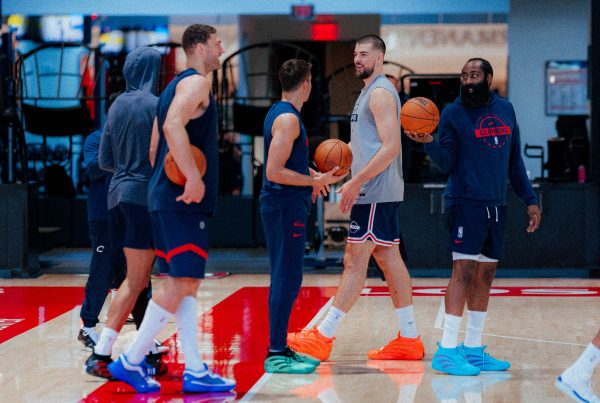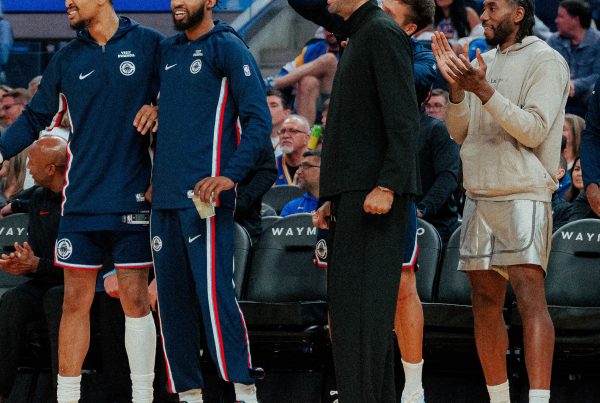As we get ready for the looming start of pre-season basketball, let’s take a look at the season preview for Marcus Morris, the Clippers’ newly re-signed starting power forward.
Basic Information
Height: 6’8″
Weight: 218 lbs
Position: Forward
Age: 31
Years in NBA: 9
Key Stats: Last season, played 43 games for the Knicks and 19 for the Clippers. As a Knick, averaged 19.6 points and 5.4 rebounds in 32.3 minutes while shooting 44.2% from the field and 43.9% from three. As a Clipper, averaged 10.1 points and 4.1 rebounds in 28.9 minutes while shooting 42.5% from the field and 31% from three.
In the playoffs with LA, averaged 11.8 points, 4.8 rebounds, and 1.6 assists per game in 29.8 minutes while shooting 50.5% from the field and 47.5% from three.
Contract Status: The Clippers re-signed Morris to a massive four-year, $64M contract in free agency last month, essentially cementing his status as a key supporting piece for years to come.
Expectations
Morris is a fairly versatile player who can help the Clippers in a lot of ways. He can be an efficient support player in start-studded lineups who can provide volume scoring with the second unit, a player who fits as a stretch power forward next to Leonard or can handle the bulk of on-ball small forward minutes in his absence, and someone who contributes on both sides of the ball as a switchable defender.
While critics of the trade that brought Morris to LA, like 213Hoops editor Robert Flom, will point out the opportunity cost of acquiring him meant not landing an upgrade at backup point guard or center, there’s little doubt that Morris is a useful contributor in a contender’s playoff rotation. The Clippers’ decision to give him such a big payday while losing high-quality backup forward JaMychal Green means that expectations for Morris have to be turned up even a little higher. The arrangement of depth on this roster suggest that he’ll end up playing the third-most minutes of anyone on the team behind Paul George and Kawhi Leonard, and he’s going to have to go beyond a useful support player and make a consistent positive impact on games.
For that to happen, he’ll need to avoid the kind of distracting incidents that he’s become infamous for in his NBA career. In each of the Clippers’ 2020 playoff series, the ugly side of Morris’ persona came out. Against the Dallas Mavericks, he took himself out of a closeout game 6 with an obvious and pointless flagrant 2 foul against Luka Doncic. In game 5 against Denver, Paul Millsap credited pre-emptive trash talk from Morris with sparking a bit of a rally in the Nuggets’ locker room at halftime. It isn’t uncommon for contending teams to have a player or two who can get a bit hotheaded or commit a hard foul on demand, but that guy can’t be third on your team in minutes and salary. Morris needs to be above it this year.
Strengths
Morris was an elite spot-up shooter last year who certainly has no fear of big shots in big moments. Last year, he hit a career-best 43.9% from deep with the Knicks before a brief slump in a small regular-season sample as a Clipper, and then knocked down 47.5% of his attempts in the playoffs. Those numbers are quite a bit ahead of his career mark of 36.7% (though he’s made 43.9% of his playoff attempts), so we’ll have to keep an eye out for any regression.
He can also score from all over the floor in middling efficiency, an attribute that can be an asset in a pinch but is hopefully something the Clippers won’t need to over-rely on. Still, in healthy doses and in the right situations, like injury-depleted regular season games or late in the shot clock of a stagnant possession, it helps to have another guy on the floor who can create his own shot.
Weaknesses
Morris’ weaknesses–aside from the aforementioned extracurriculars detracting from the team–stem largely from inconsistency. In the playoffs last year, he put together an excellent defensive series against Doncic and the Mavericks before struggling immensely with an easier assignment in Denver’s Paul Millsap. While he overall shot well, he had boom-or-bust games that included shooting a combined 3-14 in the last two games against the Nuggets. At times, when his three point shot wasn’t falling he could feel a bit invisible, which could bode poorly if his shot regresses.
He also, like many of the players featured in the Clippers’ rotation, isn’t naturally inclined to create good looks for his teammates. Last season, he had one of the NBA’s most extreme combinations of high usage rate and low assist rate, meaning he is one of the league’s most prolific black holes who finds shots for himself but not others. While Morris settled rather gracefully into a smaller role with LAC last season, taking 14 FGA per 100 possessions in the playoffs compared to 22.3 in the regular season with the Knicks, it’s worth keeping an eye on if his usage starts to drift back upwards this year. While I mentioned above that his ability to create his own shot can be an asset in certain lineups and situations, he could be prone to lean a little too far into it and pull possessions away from LA’s stronger options.
Summary
The Clippers’ decision to re-sign Morris felt like a bit of a formality, considering their trade for him at the deadline was the real indicator that they viewed him as a key piece of their supporting cast. Still, the massive four-year contract implies a lot of faith in Morris to play a significant role on a team with title aspirations, and it will be up to him to reward that trust with improved consistency and discipline.
213Hoops is an independently owned and operated L.A. Clippers blog by Clippers fans, for Clippers fans. If you enjoy our content, please consider subscribing to our Patreon. Subscriptions start at $1 a month and support from readers like you goes a long way towards helping us keep 213Hoops sustainable, growing, and thriving.




